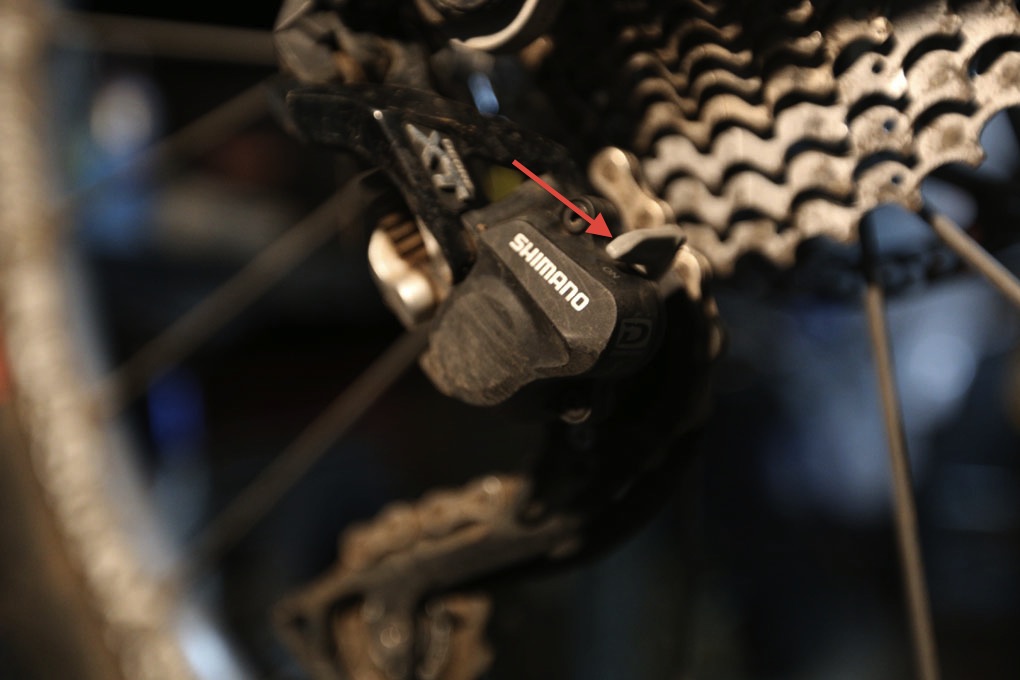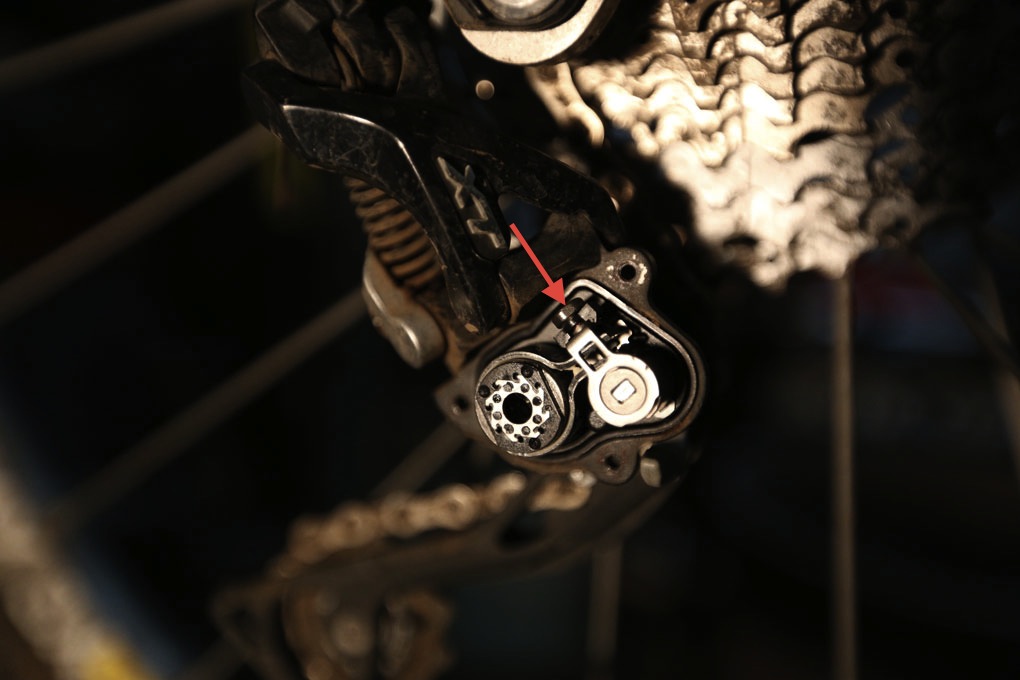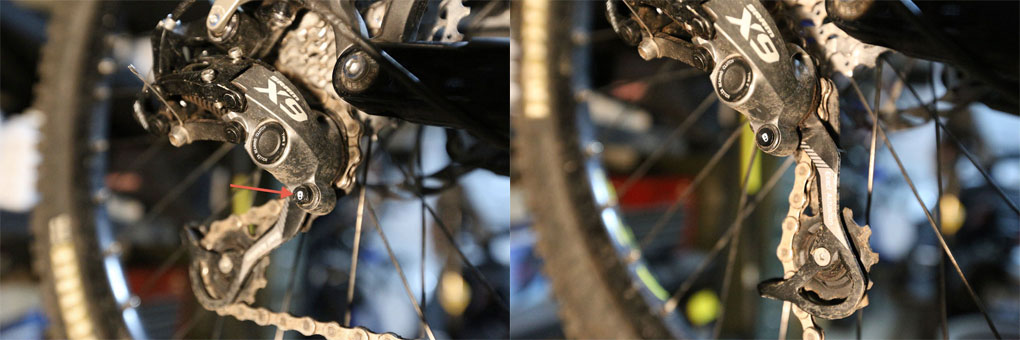The Super-Duper Awesome Part
Clutch derailleurs rule. They just do. You can grab the derailleur cage and instantly understand how they work. The loose tensioning and slackening that lets your chain show your derailleur who’s boss just isn’t there. It takes a lot more force to pull that cage forward and slacken your chain. The clutch is directional in that it allows the cage to spring back to rest position with no resistance, but the cage also barely moves forward at all. So there really isn’t much to recoil from. It really is damping for your derailleur. It works, it’s quiet, and it’s one of the few things I’ve put on my bikes that pretty much killed the chance of me ever purchasing the older system ever again. There are old forks, old tires, old rims, old frames that I can easily see myself riding, buying used, and being completely happy with. Non-clutch derailleurs—unless I’m on a road trip and just need a derailleur—I’m never buying one again.
If you’re willing to take the leap, there’s a new shifter, a new cassette and new derailleur in your future, so there’s really no reason to stay with one brand. It’s a new start, and front derailleurs are cross compatible. And the question of which way to go between the big two is something you should consider.
Due to early availability more than anything, I pulled the trigger on the first Shimano derailleur I’ve bought in about 10 years. The 9-speed era has belonged entirely to SRAM, in my opinion. I’ve ridden their derailleurs so bent, so crooked, and genuinely destroyed, and still gotten flawless shifting out them that I just shook my head for years listening to the loud, clangy crap Shimano was making. And after riding them for years and trying friends’ bikes with the “shadow” system, I still never really understood why anyone bought Shimano derailleurs and shifters. Their cassettes are awesome and incredibly smooth, and their cranks are stiff and super reliable, but that’s about it when it came to what I viewed Shimano ever doing for a drivetrain. It doesn’t take much to knock a Shimano 9-speed derailleur out of whack….So buying a Shimano derailleur was a pretty big personal step for me, but this Shimano XT setup bounced successfully between my DH bike and my trail rig, with most of its time sitting on the trail bike.
Once they were available, I also picked up a SRAM X9 Type 2 (that means “clutch”) derailleur and shifter and stuck it on my “mini-dh” bike, a Specialized SX Trail.
Since then, I’ve had hours and hours on both setups, and there are some very different approaches each company has taken to the clutch systems.
Both Shimano and SRAM put really strong retention springs in the cage knuckle. This makes sense when you think about it, because if you’re going to put friction on the thing, why not also add a bunch of spring resistance? The added tension—plus the clutch—is going to reduce the forward spring even more.
This is great when you’re riding. The cage stays put for the most part, smoothly and calmly swinging forward when it needs to for suspension movement, but, man, is it a bitch to pull the cage forward when you need to slacken the chain to pull a wheel out, or pull it back into your chainguide.
The Shimano approach is to just put a switch on the thing so that you can turn “off” the clutch system. When you do this, the cage swings pretty much like a regular old derailleur: it swings back and forth and is pretty easy to slacken up the chain.

You can also turn it off for long climbs, because as awesome as that friction is when you’re barreling downhill, you really can feel the difference in downshifting to an easier gear where the cage needs to swing forward. It’s not huge, but there is a difference, so it’s nice to have the option if you’re all bonked out on a six-hour ride with one more 2k pass to go, and phrases like “finger fatigue” start to enter your vocabulary. Something I never would have even considered had I been assigned the design task is making the damn things adjustable. But with Shimano’s system you can adjust the tension of the clutch itself.
You can see the obvious box-like appendage on the Shimano derailleurs. You can open that thing up, use an itty bitty open ended wrench, and adjust the clutch resistance. I opened mine up just to enjoy the novelty and check it out, and it’s pretty cool. I have to assume that at some point the friction points will get a little loose, so this is a nice option.

SRAM’s approach is to leave the clutch on, at all times, and add a little button thing that you can push in from the outside that moves a little metal pin in the way of the cage, keeping it from swinging back to rest position. This allows you to keep the chain slackened and do whatever work or adjustments you need to do. The pin itself is spring loaded, so as soon as some tension from the chain pulls the cage forward, the little metal pin pops back out and the cage is back in full clutch operating awesomeness. The SRAM system is also kind of a black box setup in that there’s no access to adjust the clutch friction. I haven’t felt like I needed to, but just know that it’s not there if you do wear it out.


Agreed, Since using Shimano’s new Shadow XT Plus RD I’ve been floored by the difference. I too am back buying Shimano components after a enjoyable past few years on SRAM.
Any readers got an opinion on the Zee Shadow Plus (clutch) rear mech? It’s the cheaper version of the Saint, short cage but can accommodate an 11-36 cassette which I’m considering for my 1×10 AM bike. Or would it be better to stay with an SLX if looking for an affordable clutch derailleur?
A friend just got the Zee rear derailleur for the same setup (160 travel bike setup 1×10). He’s had it for a few rides now and seems to like it. I pedaled around the parking lot and it felt pretty good. I’m considering getting the Zee setup for my SX Trail.
Lorne,
I have one and I like it. It’s on an 11-36 Shimano cassette, w a 32 ring up front on my trail bike. I have it with the Saint shifter, which is sooooo slick. it’s the best part of the system, hands down.
I must be missing something here… I run 1×10 with a medium cage XT dérailleur and don’t get any chain noise or chain slap against my frame (I’ve had people try my bike and remark on how silent the drivechain runs). There’s no chain guide, just a cheap BBG bashwhich and an correctly-sized chain for my chainring/cassette combo.
Is clutch designed for double or triple chainrings where it’s possible to get loads of loose chain when running in the smaller chainring? It just doesn’t seem relevant to my 1×10 setup.
If you’re not getting a bunch of chainslap and you can keep your chain on without a guide, then I don’t see a reason to bother with buying a clutch setup. That’s a unique combination you have though, it’s certainly not the norm (hence the remarks from your buddies). As far as single vs. multiple ring setups, I’ve run them on 1×10 setups and 2×10 setups and both benefitted greatly from the new derailleurs, trail bikes and dh bikes alike.
In response to Zack’s comment. Not all bikes running these various system suffer from the same issues. Factors such as chain length, B-Tension screw setting and frame design play a role. Example: FSR type and Giant Reign type frames make a hell of a racket. Whereas Trek Remedy is relatively quiet. Chains that come on the bike are often too long IMO. They are the spec’d length but essentially they allow for poor shifting technique (basically cross shifting) without risk of damaging the drivetrain or frame when the suspension compresses. Shift big ring to big cog and lean on the saddle while looking at the rear derailer and you’ll see what I mean. I like short chains, sometimes we swap for a longer B-Tension screw and use it to over crank the spring tension. Keeps stuff pretty quite. =)
Great review! Thanks.
So why even bother ever taking the clutch off? Why not just design the derailleur to provide the clutch function set to on all the time? By reading some reviews and feedback commwents it obviously work well, but i dont get what the benefit will be switching it off.
There’s more resistence on downshifts, enough that it’s noticeable. Not a big deal but it is more effort and on those death grind kinds of rides where you get back to your car with the stars twinkling and two hours out of water sometimes you just need life to be easy.
But mostly it just makes it easier to take the wheel off.
Hello,
The new X9 (with ball bearing start from 2012) car upshift up to 3 gears at once…